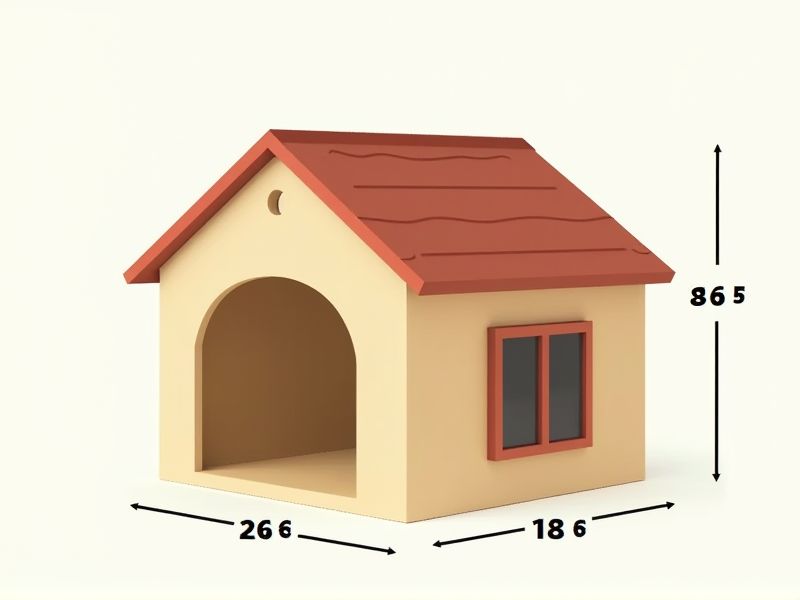
When building or purchasing a dog house, it's important to select dimensions that match your dog's size for comfort and safety. Generally, a standard dog house for a medium-sized dog is around 30 inches wide, 34 inches deep, and 32 inches high. The doorway should be about 3/4 the height of your dog's shoulder to the ground and just wide enough for them to enter comfortably--typically around 14 inches high and 12 inches wide for medium breeds. Always make sure your dog has enough space to stand up, turn around, and lie down comfortably, but avoid making the house too large, as a cozier space is easier for your dog to keep warm.
Entryway Height
The entryway height of a dog house is crucial for ensuring your pet's comfort and accessibility. Ideally, this height should be at least 2 to 4 inches taller than your dog's shoulder height, allowing them to enter without crouching. A standard entryway measurement for medium-sized breeds typically ranges between 10 to 12 inches in height. Ensuring the right entryway height not only promotes ease of access but also enhances the overall structural integrity and durability of the dog house.
Interior Height
The ideal interior height for a dog house typically ranges from 24 to 30 inches, ensuring sufficient space for most dog breeds to stand comfortably without hitting their heads. For larger breeds, an interior height closer to 36 inches is recommended to enhance their comfort and reduce the risk of stress-related behaviors. This height not only supports your dog's natural posture but also allows for better air circulation, which is crucial for maintaining a healthy environment. When selecting or constructing a dog house, prioritizing these height measurements will significantly enhance your pet's overall well-being.
Floor Area
The ideal floor area for a dog house varies depending on the dog's size; for small breeds, a minimum of 24 inches by 24 inches is recommended, while large breeds require at least 36 inches by 36 inches. Proper ventilation is crucial to maintain a comfortable environment, with at least one vent for every 10 square feet of floor space. The house should also be elevated off the ground, ideally 6 inches, to prevent moisture accumulation and ensure warmth. A well-insulated structure can help regulate temperature, which is essential for your dog's comfort in extreme weather conditions.
Roof Overhang
A dog house should ideally feature a roof overhang of at least 6 inches to provide protection from rain and direct sunlight. This overhang helps to maintain a comfortable temperature inside, reducing heat during summer months and keeping the interior dry during wet weather. Proper roof design also prevents water pooling on the roof, which can lead to structural damage over time. Your dog's shelter will be more functional and durable with a well-constructed roof overhang, ensuring a cozy retreat for your pet.
Door Width
The standard door width for a dog house typically ranges from 8 to 12 inches, accommodating various breeds comfortably. For smaller dogs, a narrower door of around 8 inches may suffice, while larger breeds may require a width closer to 12 inches. Ensuring the door height is adequate, usually between 12 to 24 inches, is essential for your dog's ease of access. This optimal sizing promotes both safety and comfort, allowing your pet to move in and out freely without stress.
Sleeping Area Size
The ideal sleeping area for a dog house should accommodate your pet's size comfortably, with a recommended minimum space of 30 inches long by 24 inches wide for medium breeds. For larger breeds, a sleeping area of at least 36 inches long by 30 inches wide is advisable to allow for stretching and turning. Proper height is also crucial; the internal height should be at least 4 inches taller than your dog's standing height to prevent discomfort. Ensuring adequate sleeping space promotes better rest, essential for your dog's overall health and well-being.
Ventilation Space
Effective ventilation in a dog house is crucial for maintaining a comfortable environment, especially during extreme weather conditions. The ideal ventilation space should account for a minimum of 10% of the floor area, ensuring adequate air circulation while preventing drafts. Proper airflow helps regulate temperature and humidity levels, significantly reducing the risk of heat stress or respiratory issues for your dog. Incorporating adjustable vents or windows can enhance airflow, allowing you to customize the environment according to seasonal changes.
Insulation Thickness
The insulation thickness of a dog house plays a critical role in maintaining a comfortable environment for your pet, particularly in extreme weather conditions. A recommended insulation thickness is between 1.5 to 2 inches, which effectively regulates temperature, ensuring warmth in winter and coolness in summer. High-quality insulation materials like foam board or reflective insulation can significantly enhance energy efficiency, reducing heating and cooling costs by up to 30%. Investing in proper insulation not only safeguards your dog's health but also prolongs the lifespan of the dog house.
Material Choice
When selecting a dog house, prioritize durable materials that enhance both comfort and protection. Opt for sturdy wood or high-quality plastic, which can withstand various weather conditions and resist wear and tear. Insulation is crucial, so consider models featuring thermal barriers to keep your dog warm in winter and cool in summer. Additionally, look for non-toxic finishes to ensure the safety of your furry friend, as well as easy maintenance options for convenience.
Assembly Complexity
The assembly complexity of a dog house can vary significantly, with simpler designs requiring minimal tools and around 30 minutes for assembly, while more intricate models may take up to two hours and need specialized tools. Modular dog houses often feature interlocking components that enhance ease of assembly, making them suitable for pet owners who prefer a quick setup. Additionally, pre-cut sections in DIY kits can reduce the overall complexity, promoting efficient assembly without sacrificing durability. Prioritizing user-friendly instructions and labeled parts can further streamline the construction process, ensuring a safe and comfortable environment for your dog.
